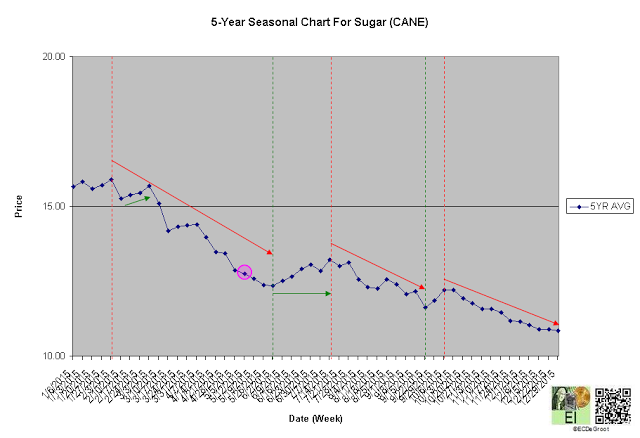The International Sugar Organization (ISO), assuming average growth in global sugar demand, forecasts a looming world production deficit of more than 6 m tonnes over the next two seasons. It also forecasts a 2.3m tonne shortfall in 2015-2016. This is the first shortfall in six years. Sugar, driven more by the invisible hand following deflationary forces than the ISO forecasts, has been mired in a bear market despite production deficits since 2011.
Investors, largely driven by emotions rather than discipline, tend to focus on volatility rather than the message of the market. This tendency prevents them from recognizing better opportunities in quieter markets.
Insights constructs and interprets the message of the market, the flow of sentiment, price, leverage, and time in order to define trends within the cycle of accumulation and distribution for subscribers.
Summary
The BULL (Price) and BULL (Leverage) trends under Q3 distribution after the seasonal high position sugar as a focused bull opportunity since the third week of March.
Price
Interactive Charts: CANE, CANE PF, SUGAR
The long-term trend oscillator (LTCO) defines an up impulse and 3% annualized gain from 10.86 to 10.91 since the third week of March (chart 1). The bulls control the trend until reversed by a bearish crossover. Compression, the final phase of the CEC cycle, generally anticipates this change.
A close above 12.89 jumps the creek and transitions the trend from mark down to cause, while a close below 8.39 breaks the ice and resumes mark down.
Chart 1
Leverage
The long-term leverage oscillator (LTLO) defines a bull phase and since the second week of March (chart 2). This focuses the up impulse (see price).
A diffusion index (DI) of -54% defines Q3 distribution (chart 3). A capitulation index (CAP) of -18% supports this message (chart 4). DI and CAP's trends, broader flows of leverage and sentiment from accumulation to distribution and fear to complacency supporting the bulls (red arrows), should not only continue to extreme concentrations but also restrain downside expectations until reversed (see price). A decline under these trends, a sign of weakness (SOW) observed since early 2015, would be bearish for sugar longer-term.
Chart 2
Chart 3
Chart 4
Time/Cycle
The 5-year seasonal cycle defines weakness until the first week of June (chart 5). This path of least resistance restrains upside expectations (see price).
Chart 5





